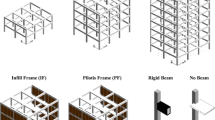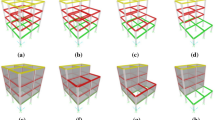Abstract
Recent seismic events have raised concerns over the safety and vulnerability of reinforced concrete moment resisting frame “RC-MRF” buildings. The seismic response of such buildings is greatly dependent on the computational tools used and the inherent assumptions in the modelling process. Thus, it is essential to investigate the sensitivity of the response demands to the corresponding modelling assumption. Many parameters and assumptions are justified to generate effective structural finite element (FE) models of buildings to simulate lateral behaviour and evaluate seismic design demands. As such, the present study focuses on the development of reliable FE models with various levels of refinement. The effects of the FE modelling assumptions on the seismic response demands on the design of buildings are investigated. the predictive ability of a FE model is tied to the accuracy of numerical analysis; a numerical analysis is performed for a series of symmetric buildings in active seismic zones. The results of the seismic response demands are presented in a comparative format to confirm drift and strength limits requirements. A proposed model is formulated based on a simplified modeling approach, where the most refined model is used to calibrate the simplified model.
Similar content being viewed by others
References
American Concrete Institute Committee (2011), Building Code Requirements for Structural Concrete (ACI 318-11) and Commentary, ACI 318R-11, Farmington Hills, MI.
American Society of Civil Engineers (2005), Minimum Design Loads for Buildings and Other Structures, ASCE 7–05, Reston, Virginia.
American Society of Civil Engineers (2006), Seismic Rehabilitation of Existing Buildings, ASCE/SEI 41–06, Reston, VA.
American Society of Civil Engineers (2010), Minimum Design Loads for Buildings and Other Structures, ASCE/SEI Standard 7–10, Reston, Virginia.
Applied Technology Council (2009), Guidelines for Seismic Performance Assessment of Buildings, ATC 58, 50 % Draft Report, Redwood City, CA.
Building Seismic Safety Council (2003), NEHRP Recommended Provisions for the Development of Seismic Regulations for New Buildings, FEMA 450, Washington, DC.
Comité Européen de Normalisation (2005), Eurocode 8 - CEN. Design of Structures for Earthquake Resistance, Part 1: General Rules, Seismic Actions and Rules for Buildings, EN 1998–1, Brussels, Belgium.
Computers and Structures Inc. (2015), ETABS: Integrated Software for Structural Analysis and Design, Computers and Structures Inc., Berkeley, CA.
Housing and Building Research Center (2007), Egyptian Code of Practice for Design of Reinforced Concrete Structures, Ministry of housing, utilities and urban communities of the ARE, ECP 203, Egypt.
Housing and Building Research Center (2008), Egyptian Code of Practice for Loads on Buildings and Bridge, Ministry of Housing, Utilities and Urban Communities of the ARE, ECP 201, Egypt.
Federal Emergency Management Agency (1997), NEHRP Guidelines for the Seismic Rehabilitation of Buildings, FEMA-273, Washington, DC.
Federal Emergency Management Agency (2000), Prestandard and Commentary for the Seismic Rehabilitation of Buildings, FEMA 356 Report, Washington, D.C.
International Code Council (2000), International Building Code, Falls Church, VA.
International Congress of Building Officials (1997), Uniform Building Code, Whittier, California.
National Research Council of Canada (2005), National Building Code of Canada, 12th Ed, Canadian Commission on Building and Fire Codes, Ottawa, Ont.
Pacific Earthquake Engineering Research Center, Applied Technology Council (2010), Modelling and Acceptance Criteria for Seismic Design and Analysis of Tall Buildings, PEER/ATC 72–1 Report, Redwood, CA.
Pacific Earthquake Engineering Research Center (2010), Seismic Design Guidelines for Tall Buildings, University of California at Berkeley, Berkeley, CA.
Saudi Building Code National Committee (2007), Saudi Building Code for Load and Forces Requirements, SBC 301, Riyadh, Saudi Arabia.
Abdel Raheem SE (2013), “Evaluation of Egyptian Code Provisions for Seismic Design of Moment Resisting Frames Multi-Story Buildings,” International Journal of Advanced Structural Engineering, 5(20): 1–18.
Abdel Raheem SE, Ahmed MM and Alazrak TMA (2015), “Evaluation of Soil-Foundation-Structure Interaction Effects on Seismic Response Demands of Multi-Story MRF Buildings on Raft Foundations,” International Journal of Advanced Structural Engineering, 7(1): 11–30.
Abdel Raheem SE, Ahmed MMM, Ahmed MM and Abdel Shafy AGA (2018a), “Evaluation of Plan Configuration Irregularity Effects on Seismic Response Demands of L-Shaped MRF Buildings,” Bulletin of Earthquake Engineering. DOI: 10.1007/s10518-018-0319-7.
Abdel Raheem SE, Fooly MYM, AbdelShafy AGA, Abbas YA, Omar M, AbdelLatif MMS and Mahmoud S (2018b), “Seismic Pounding Effects on Adjacent Buildings in Series with Different Alignment Configurations,” Steel & Composite Structures, An International, Techno-Press publishers.
Chan THT and Chan JHF (1999), “The Use of Eccentric Beam Elements in the Analysis of Slab-on-Girder Bridges,” Structural Engineering and Mechanics, 8(1): 85–102.
Elnashap AS and McClure DC (1996), “Effect of Modelling Assumptions and Input Motion Characteristics on Seismic Design Parameters of RC Bridge Piers,” Earthquake Engineering and Structural Dynamics, 25: 435–453.
Elwood KJ, Matamoros AB, Wallace JW, Lehman DE, Heintz JA, Mitchell AD, Moore MA, Valley MT, Lowes LN, Comartin CD and Moehle JP (2007), “Update to ASCE/SEI 41 Concrete Provisions,” Earthquake Spectra, 23(3): 493–523.
Fayun L, Haibing C and Maosong H (2017), “Accuracy of Three-Dimensional Seismic Ground Response Analysis in Time Domain Using Nonlinear Numerical Simulations,” Earthquake Engineering and Engineering Vibration, 16(3): 487–498. DOI:10.1007/s11803-017-0401-1.
Hur J, AlthoffE, Sezen H, Denning R and Aldemir T (2017), “Seismic Assessment and Performance of Non-structural Components Affected by Structural Modeling,” Nuclear Engineering and Technology, 49: 387–394.
Hwang SH and Lignos DG (2017), “Effect of Modeling Assumptions on the Earthquake-Induced Losses and Collapse Risk of Steel-Frame Buildings with Special Concentrically Braced Frames,” ASCE Journal of structural Engineering, 143(9): 04017116–1. DOI: 10.1061/(ASCE) ST.1943-541X.0001851.
Jayasinghe JASC, Hori M, Riaz MR, Wijerathne MLL and Ichimura T (2017), “Conversion Between Solid and Beam Element Solutions of Finite Element Method Based on Meta-Modeling Theory: Development and Application to a Ramp Tunnel Structure,” Earthquake Engineering and Engineering Vibration, 16(2): 297–309. https://doi.org/10.1007/s11803-017-0383-z
Krawinkler H (2000), “The State-of-the-Art Report on System Performance of Moment Resisting Steel Frames Subjected to Earthquake Ground Shaking,” Federal Emergency Management Agency, FEMA 355c, Washington, DC.
Kwon J and Ghannoum WM (2016), “Assessment of International Standard Provisions on Stiffness of Reinforced Concrete Moment Frame and Shear Wall Buildings,” Engineering Structures, 128: 149–160.
Lee DG, Ahn SK and Kim DK (2003), “An Efficient Model for Seismic Analysis of Building Structures with The Effect of Floor Slabs,” 7th Pacific Conference on Earthquake Engineering-7PCEE, University of Canterbury, Christchurch, New Zealand, 13–15 February 2003, Paper No. 045.
Le-Trung K, Lee K, Lee J and Lee DH (2010), “Seismic Demand Evaluation of Steel MRF Buildings with Simple and Detailed Connection Models,” International Journal of Steel Structures, 10(1): 15–34.
Li Jianbo, Lin Gao, Lin Jun and Li Zhiyuan (2017), “Research on the Attribution Evaluating Methods of Dynamic Effects of Various Parameter Uncertainties on the In-Structure Floor Response Spectra of Nuclear Power Plant,” Earthquake Engineering and Engineering Vibration, 16(1): 47–54. https://doi.org/10.1007/s11803-017-0367-z.
Mehanny SSF and El Howary HA (2010), “Assessment of RC Moment Frame Buildings in Moderate Seismic Zones: Evaluation of Egyptian Seismic Code Implications and System Configuration Effects,” Engineering Structures, 32: 2394–2406.
Mehanny SSF, Soliman AM and Bakhoum MM (2012), “Strength & Drift Seismic Code Requirements for Mid-Rise RC Frame Buildings,” Global Thinking In Structural Engineering: Recent Achievements IABSE Conference, 98, Sharm El Sheikh, Egypt, 7–9 May, Paper No. 97.
Rivera JA and Petrini L (2011), “On the Design and Seismic Response of RC Frame Buildings Designed with Eurocode 8,” Bulletin of Earthquake Engineering, 9: 1593–1616.
Roca P, Cervera M, Gariup G and Pela L (2010), “Structural Analysis of Masonry Historical Constructions. Classical and Advanced Approaches,” Arch Computational Methods Engineering, 17: 299–325. DOI 10.1007/s11831-010-9046-1
Shin M, Kang TH-K and Grossman JS (2010), “Practical Modelling of High-Rise Dual Systems with Reinforced Concrete Slab-Column Frames,” The Structural Design of Tall and Special Buildings, 19(7): 728–749.
Soliman AM, Mehanny SSF and Bakhoum MM (2012), “Effect of FEM Modelling Assumptions and Code Provisions on Seismic Analysis of RC Buildings,” Global Thinking In Structural Engineering: Recent Achievements IABSE Conference, 98, Sharm El Sheikh, Egypt, 7–9 May 2012, Paper No. 99.
Sousa R, Eroğlu T, Kazantzidou D, Kohrangi M, Sousa L, Nascimbene R and Pinho R (2012), “Effect of Different Modelling Assumptions on the Seismic Response of RC Structures,” 15th World Conference on Earthquake Engineering, Lisbon, Portugal, 24–28 September 2012, Paper ID 4333.
Vona M and Mastroberti M (2018), “Estimation of the Behavior Factor of Existing RC-MRF Buildings,” Earthquake Engineering and Engineering Vibration, 17(1): 191–204. https://doi.org/10.1007/s11803-018-0434-0
Walker S, Yeargin C, Lehman D and Stanton J (2002), “Influence of Joint Shear Stress Demand and Displacement History on the Seismic Performance of Beam-Column Joints,” The Third US-Japan Workshop on Performance-Based Earthquake Engineering Methodology for Reinforced Concrete Building Structures, Seattle, USA, 16–18 August 2001, Report No. PEER-2002/02: 349–362.
Wallace JW (2007), “Modelling Issues for Tall Reinforced Concrete Core Wall Buildings,” The Structural Design of Tall and Special Buildings, 16(5): 615–632.
Willford M, Whittaker A and Klemencic R (2008), “Recommendations for the Seismic Design of High-Rise Buildings,” Council on Tall Buildings and Urban Habitat, Illinois Institute of Technology, Chicago, IL.
Zendaoui A, Kadid A and Yahiaoui D (2016), “Comparison of Different Numerical Models of RC Elements for Predicting the Seismic Performance of Structures,” International Journal of Concrete Structures and Materials, 10(4): 461–478.
Zeris C, Vamvatsikos D, Giannitsas P and Alexandropoulos K (2007), “Impact of FE Modelling in the Seismic Performance Prediction of Existing RC Buildings,” ECCOMAS Thematic Conference on Computational Methods in Structural Dynamics and Earthquake Engineering - COMPDYN 2007, Rethimno, Greece, 13–16 June 2007.
Acknowledgement
The financial support by Scientific Research Deanship, Taibah University Grant no. 6363/436 is gratefully acknowledged.
Author information
Authors and Affiliations
Corresponding author
Additional information
Scientific Research Deanship, Taibah University Grant No. 6363/436
Rights and permissions
About this article
Cite this article
Abdel Raheem, S.E., Abdel Zaher, A.K. & Taha, A.M. Finite element modeling assumptions impact on seismic response demands of MRF-buildings. Earthq. Eng. Eng. Vib. 17, 821–834 (2018). https://doi.org/10.1007/s11803-018-0478-1
Received:
Accepted:
Published:
Issue Date:
DOI: https://doi.org/10.1007/s11803-018-0478-1




